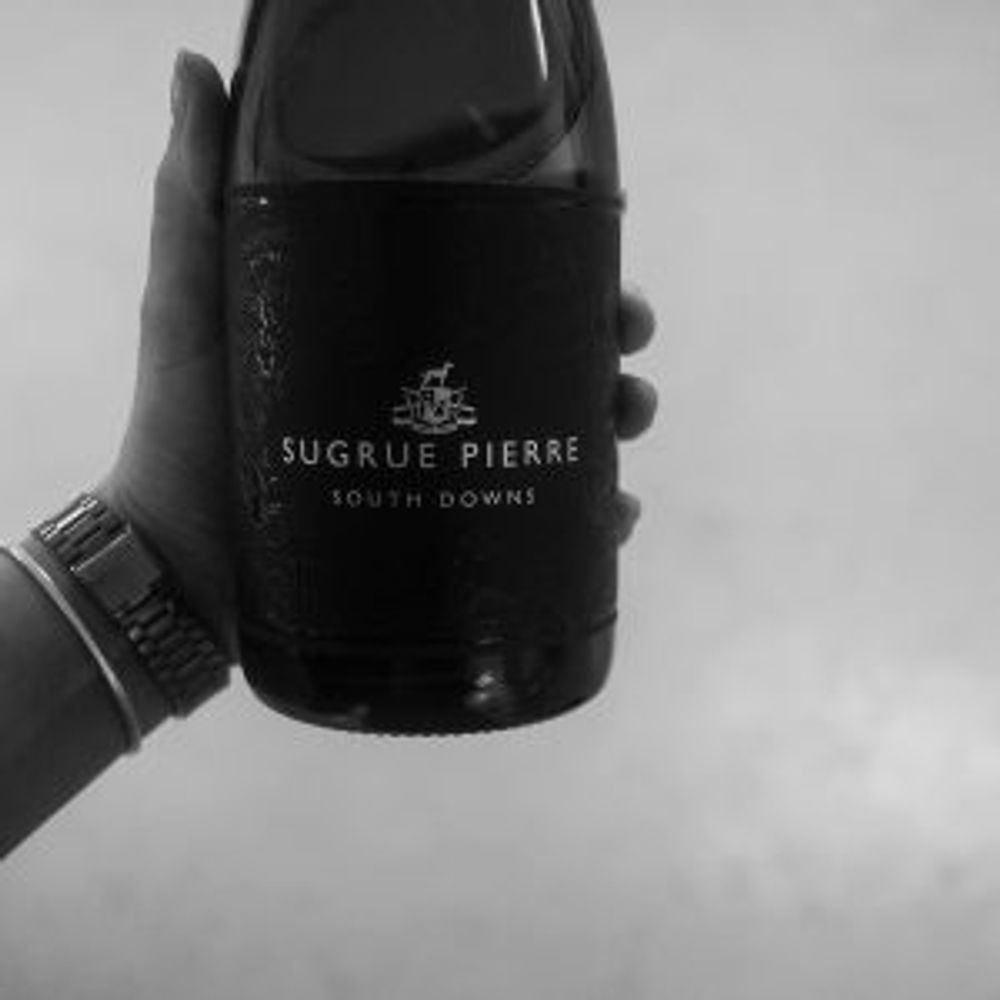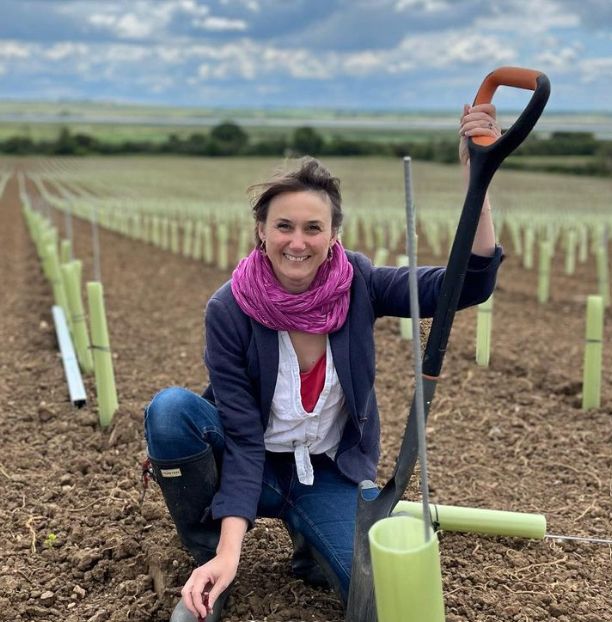Christina tastes “the most breathtaking English wine I have tried to date” in the Wiston Estate Rosé 2011 as well as some other gems made by Dermot Sugrue
On a beautiful English Spring day, I drove down the A23 from London to the South Downs. Wiston Estate Winery is situated next to Chanctonbury Game – resonating well with eating and drinking as locally as possible.

Dermot Sugrue. You cannot underestimate his importance to the English wine industry.
I parked up next to a big old building, where Dermot came to meet me. He took me outside, round to the entrance, where there was a sign for a car factory, explaining that it had originally been a turkey abattoir before being converted into a car workshop, before finally finding its place as the Wiston Estate Winery.
Spooky.
Turkey souls floating around amongst the barrels.
Meanwhile, Noodles and Tara, Dermot’s two greyhound crosses, followed us loyally everywhere we went. Perhaps they were looking for the turkeys.

The winery was founded in 2008. Today, 25% of production accounts for Wiston wines, and Dermot makes wine for the other 75% – most commonly from grapes received from other domaines, but also from still wine received from other wineries.
For example, Bothy Vineyard in Oxfordshire, where they make tiny production wines from all sorts of rare and interesting varietals, Dermot will be “putting the bubbles” into their blend of Rondo, Regent and Dornfelder, Huxelrebe, Findling, Perle and Bacchus. The production is tiny just 1000 or so bottles.
He also makes wines for many other well known wineries in the UK – Jenkyn Place, Coldharbour, English Oak Vineyard and Digby to name but a few.
Dermot began making beer when he was 15, and then wine at 16 – out of any fruit he could find, as well as importing grape juice. It’s his passion, which led to him becoming head winemaker at Nyetimber, and then led him to Wiston in 2008.
Vineyard and winery work is carried out meticulously. Harvest is done by hand in small crates, and loaded by hand into the gentle bladder press.

Weston’s Coquard press – only one of four outside France
Meanwhile for the Wiston wines and Dermot’s own Sugrue Pierre wine, pressing takes place in this rather beautiful Coquard press. It is unique to the UK and one of only four outside of France. It was created in 1973 and previously belonged to Champagne Martel. It is incredibly gentle, taking approximately four hours, and is tough work – carried out by some strong Lithuanian guys who have to “break the cake” four times during each press cycle. The wine is then gravity fed.
Wine is aged in what was once a freezer for the aforementioned turkeys – a big, cool, insulated, fairly creepy room that one might imagine as a good setting for a horror film. Dermot explained this to me with such happy enthusiasm. It means, of course, that the room has ideal temperatures for ageing wine. Amazing.
Who would have thought that turkey death could equate to fantastic winemaking?

The vineyards at Wiston Estate Winery
We hopped in the car to go to the Wiston vineyard, just round the corner.
Vines are Single Guyot trained, and the soil is ploughed seven to eight times with a Boisselet plough – so Wiston is organic by soil terms. After ploughing, it’s important to cross your fingers and hope for no rain, to ensure the weeds don’t grow back. Dermot pointed to a little uprooted weed: “See him? All he needs is a little rain to grow back.”
Spraying is kept to a minimum but, due to climate is necessary – downy and powdery mildew as well as botrytis can cause huge issues in English vineyards.
Speaking about issues with English wine I asked whether ripening was ever a problem? to which Dermot replied no. The issue for the English wine is the huge fluctuation in yield, due to troublesome weather, as outlined below…
2008 – 24 tons
2009 – 90 tons
2010 – 150 tons
2011 – 60 tons
2012 – 11 tons (darkest, wettest and coldest summer since 1912)
2013 – 186 tons
2014 – 330 tons!
That’s England for you… unpredictable, but capable of incredible things.
Wiston is also one of the few estates in the UK to have high plantings of Meunier.
Dermot stated, “Not many others plant it – perhaps people don’t get it. I do, it suits the UK. In Champagne it is the most planted varietal.”
THE WINES
Wiston Blanc de Blancs NV
The base wine here is 2014, with additions of 2013 and 2009. Some wine is barrel-aged. Zesty on the nose with lots of lemon and a distinct mineral/chalky edge with some fresh dough notes. A little pith and some lime and apple on the palate, with a delicious light biscuit finish.
Cuvée Brut Wiston NV
Aged in tank here. This is a richer example on the nose, with tons of fruit – particularly red apples (from the Meunier) and apple skin, with a lifted citrus edge. It has a lovely yeasty complexity on the palate, with a soft creamy texture. Very drinkable.
Equal parts of Chardonnay, Pinot Noir and Pinot Meunier
Wiston Estate Rosé 2011

Due to an exceptional year – small crop from flowering and heat wave in September – this wine has incredible concentration. Indeed it hadn’t been intended as a rosé, but the concentration was such that the wine coloured naturally. It was the warmest September in meteorologically recorded history.
It’s the most breathtaking English wine I have tried to date.
A lovely, lifted, elegant nose: wild strawberries, with some rose and nutmeg. On the palate there are more wild strawberries, raspberries, soft cherry notes and some lovely pear – possibly from the Chardonnay. It has an exceptionally long finish.
57% Pinot Noir, 33% Chardonnay and 10% Pinot Meunier
Dermot also makes his own wine. This comes from Storrington Priory at the foot of the South Downs, and more recently also includes fruit from an exceptional site: Mount Harry in Lewes, East Sussex.
The Trouble With Dreams (experimental cuvée with 12g/L as opposed to the usual 6)
Dermot has made an experimental batch of The Trouble With Dreams 2013 with 12g/L instead of 6g/L. Still a Brut, but fleshier and more intense. Highly concentrated, recently disgorged. Ripe red and green apples, mineral leanness, this is a fantastic wine in the making, still just a baby.
The Trouble With Dreams 2010, Sugrue Pierre

A very ripe vintage – 2010 is Dermot’s favourite. Highly complex nose with lacy energy. It dances. A lovely elegant wine. Green apple notes with lemony hints, a very attractive saline mid-palate and a crab shell edge. Still quite lean, this will age beautifully. The dog on the label is Dermot’s Noodles.
55% Chardonnay, 40% Pinot Noir and 5% Pinot Meunier
Chatting to Dermot in his winery and in the vineyard left me contemplating all week about how monumentally important he is to the English wine industry.
Not only that, but he’s an amazing guy too. Incredibly kind, patient and chatty – the UK is lucky to have him. He has just won all the top medal spots at the IWEA, a very well deserved achievement. He has also just been travelling in South Africa, visiting the likes of Adi Badenhorst for some more wine inspiration.
He has a very exciting future ahead.
Wiston wines are available through Corney and Barrow. Sugrue Pierre is through Hallgarten Druitt Novum. Both ranges are available to buy directly through the website. The Wiston Rosé is also available to buy to consumers through SWiG.










































